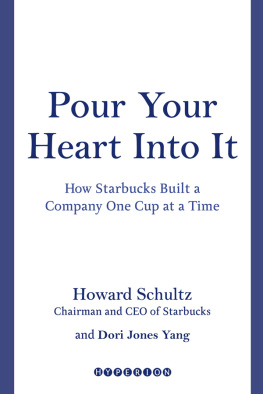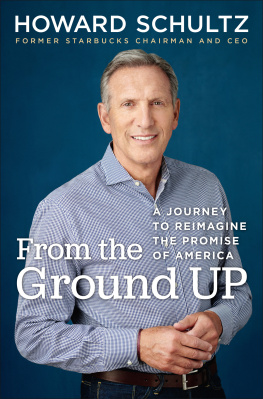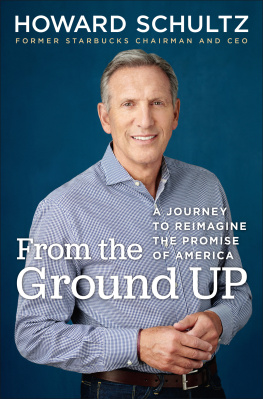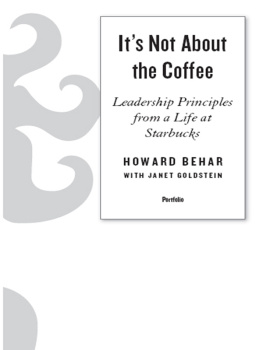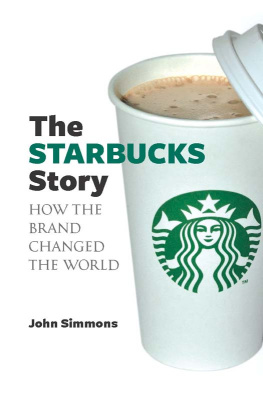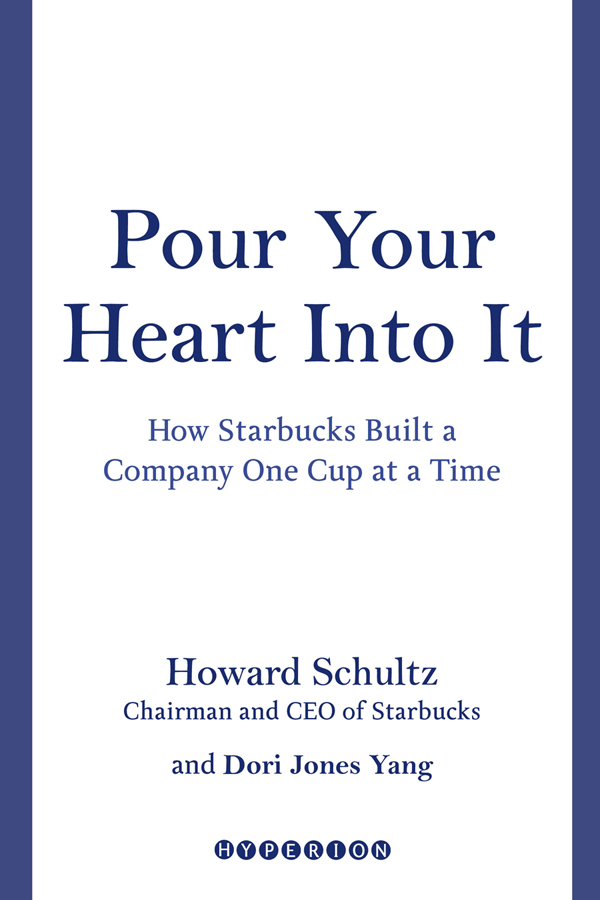
Pour Your Heart Into It

This books is dedicated with love to my wife, Sheri, to my mother, to the memory of my father and to all my partners at Starbucks, especially Mary Ciatrin Mahoney, Aaron David Goodrich, and Emory Allen Evans. You live on in our hearts.
Contents
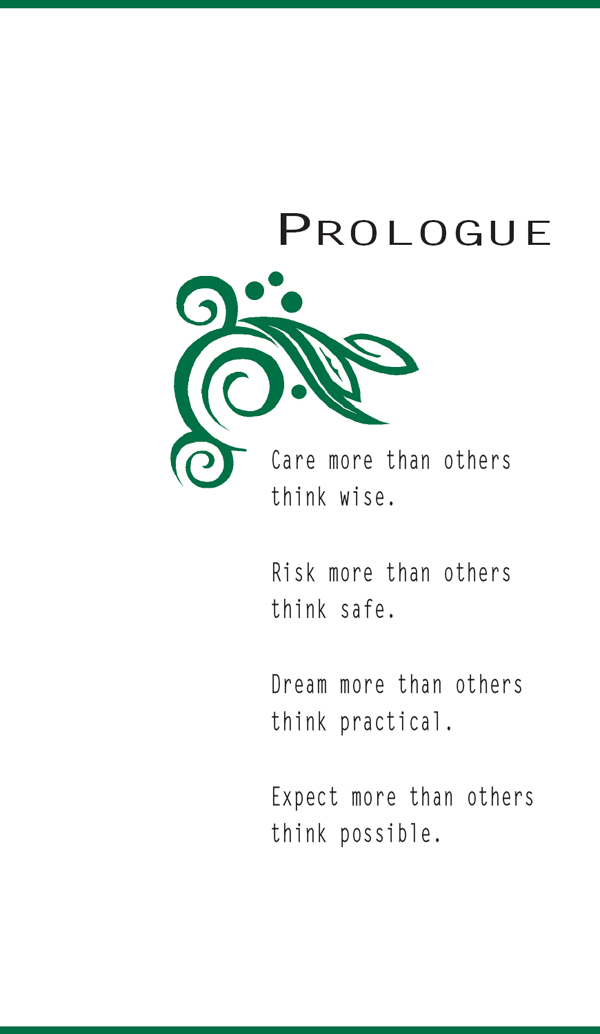
On a cold January day in 1961, my father broke his ankle at work.
I was seven years old at the time and in the midst of a snowball fight in the icy playground behind my school when my mother leaned out our seventh-floor apartment window and waved wildly in my direction. I raced home.
Dad had an accident, she told me. I have to go to the hospital.
My father, Fred Schultz, was stuck at home with his foot up for more than a month. Id never seen a cast before, so it fascinated me at first. But the novelty quickly wore off. Like so many others of his station in life, when Dad didnt work, he didnt get paid.
His latest job had been as a truck driver, picking up and delivering diapers. For months, he had complained bitterly about the odor and the mess, saying it was the worst job in the world. But now that he had lost it, he seemed to want it back. My mom was seven months pregnant, so she couldnt work. Our family had no income, no health insurance, no workers compensation, nothing to fall back on.
At the dinner table, my sister and I ate silently as my parents argued about how much money they would have to borrow, and from whom. Sometimes, in the evening, the phone would ring, and my mother would insist I answer it. If it was a bill collector, she instructed me to say my parents werent at home.
My brother, Michael, was born in March; they had to borrow again to pay the hospital expenses.
Years later, that image of my fatherslumped on the family couch, his leg in a cast, unable to work or earn money, and ground down by the worldis still burned into my mind. Looking back now, I have a lot of respect for my dad. He never finished high school, but he was an honest man who worked hard. He sometimes had to take on two or three jobs just to put food on the table. He cared a lot about his three kids, and played ball with us on weekends. He loved the Yankees.
But he was a beaten man. In a series of blue-collar jobstruck driver, factory worker, cab driverhe never made as much as $20,000 a year, never could afford to own his own home. I spent my childhood in the Projects, federally subsidized housing, in Canarsie, Brooklyn. By the time I was a teenager, I realized what a stigma that carried.
As I got older, I often clashed with my dad. I became bitter about his underachievement, his lack of responsibility. I thought he could have accomplished so much more, if he had only tried.
After he died, I realized I had judged him unfairly. He had tried to fit into the system, but the system had crushed him. With low self-esteem, he had never been able to climb out of the hole and improve his life.
The day he died, of lung cancer, in January 1988, was the saddest of my life. He had no savings, no pension. More important, he had never attained fulfillment and dignity from work he found meaningful.
As a kid, I never had any idea that I would one day head a company. But I knew in my heart that if I was ever in a position where I could make a difference, I wouldnt leave people behind.
My parents could not understand what it was that attracted me to Starbucks. I left a well-paying, prestigious job in 1982 to join what was then a small Seattle retailer with five stores. For my part, I saw Starbucks not for what it was, but for what it could be. It had immediately captivated me with its combination of passion and authenticity. If it could expand nationwide, romancing the Italian artistry of espresso-making as well as offering fresh-roasted coffee beans, I gradually realized, it could reinvent an age-old commodity and appeal to millions of people as strongly as it appealed to me.
I became CEO of Starbucks in 1987 because I went out, as an entrepreneur, and convinced investors to believe in my vision for the company. Over the next ten years, with a team of smart and experienced managers, we built Starbucks from a local business with 6 stores and less than 100 employees into a national one with more than 1,300 stores and 25,000 employees. Today we are in cities all over North America, as well as in Tokyo and Singapore. Starbucks has become a brand thats recognized nationally, a prominence than gives us license to experiment with innovative new products. Both sales and profits have grown by more than 50 percent a year for six consecutive years.
But the story of Starbucks is not just a record of growth and success. Its also about how a company can be built in a different way. Its about a company completely unlike the ones my father worked for. Its living proof that a company can lead with its heart and nurture its soul and still make money. It shows that a company can provide long-term value for shareholders without sacrificing its core belief in treating its employees with respect and dignity, both because we have a team of leaders who believe its right and because its the best way to do business.
Starbucks strikes an emotional chord with people. Some drive out of their way to get their morning coffee from our stores. Weve become such a resonant symbol of contemporary American life that our familiar green siren logo shows up frequently on TV shows and in movies. Weve introduced new words into the American vocabulary and new social rituals for the 1990s. In some communities, Starbucks stores have become a Third Placea comfortable, sociable gathering spot away from home and work, like an extension of the front porch.
People connect with Starbucks because they relate to what we stand for. Its more than great coffee. Its the romance of the coffee experience, the feeling of warmth and community people get in Starbucks stores. That tone is set by our baristas, who custom-make each espresso drink and explain the origins of different coffees. Some of them come to Starbucks with no more skills than my father had, yet theyre the ones who create the magic.
If theres one accomplishment Im proudest of at Starbucks, its the relationship of trust and confidence weve built with the people who work at the company. Thats not just an empty phrase, as it is at so many companies. Weve built it into such ground-breaking programs as a comprehensive health-care program, even for part-timers, and stock options that provide ownership for everyone. We treat warehouse workers and entry-level retail people with the kind of respect most companies show for only high executives.
These policies and attitudes run counter to conventional business wisdom. A company that is managed only for the benefit of shareholders treats its employees as a line item, a cost to be contained. Executives who cut jobs aggressively are often rewarded with a temporary run-up in their stock price. But in the long run, they are not only undermining morale but sacrificing the innovation, the entrepreneurial spirit, and the heartfelt commitment of the very people who could elevate the company to greater heights.
What many in business dont realize is that its not a zero-sum game. Treating employees benevolently shouldnt be viewed as an added cost that cuts into profits, but as a powerful energizer that can grow the enterprise into something far greater than one leader could envision. With pride in their work, Starbucks people are less likely to leave. Our turnover rate is less than half the industry average, which not only saves money but strengthens our bond with customers.
Next page
